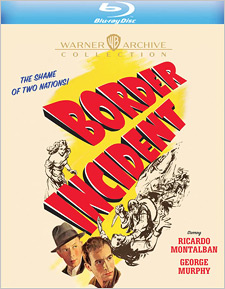Border Incident (Blu-ray Review)

Director
Anthony MannRelease Date(s)
1949 (May 2, 2023)Studio(s)
MGM (Warner Archive Collection)- Film/Program Grade: A
- Video Grade: A
- Audio Grade: A
- Extras Grade: C
Review
Though widely regarded as great film noir, Anthony Mann’s Border Incident (1949) still somehow is deserving of even more praise. It operates from a socio-political premise still relevant, unchanged even now. Its terrific suspense is palpable, spread across nearly the entire film and has not dated. And it’s realistically violent, one scene in particular offering what is maybe the most shocking, grisliest murder in a Hollywood film of the 1940s.
Almost equally shocking is that the film was produced by MGM, whose middle-American wholesomeness had been carefully nurtured by Louis B. Mayer. When Dore Schary replaced Mayer in the late forties, he moved the company away from the sugary sweetness of the Andy Hardy films and headlong into darker “message pictures.” Schary’s experiment was mostly a financial disaster for MGM. Even a picture as good as Border Incident lost money.
Along the California-Mexico border, migrant farm workers, braceros, are being smuggled into the country illegally. Once inside the U.S. they are forced into indentured servitude, working for peanuts, and often robbed and murdered on their way back to Mexico. A joint task force of Mexican and American officials agrees to put forth a plan by immigration investigators Pablo Rodriguez (Ricardo Montalbán) from Mexico and Jack Bearnes (George Murphy) from the U.S. Pablo goes undercover as a bracero looking for work, while Jack plans to follow and monitor him as Pablo works his way through the illegal immigration network.
In Mexico, Pablo befriends another bracero, Juan Garcia (James Mitchell), desperate for work, and they’re able to buy transport via one part of the network managed by sleazy German Hugo Ulrich (Sig Ruman). Snuck across the border, the braceros are put to underpaid work by trafficker Owen Parkson (Howard Da Silva) until forged immigration papers will allow him to ship the workers to their final destinations. Jack, meanwhile, poses as a wanted man anxious to unload several thousand of these forged documents, which Parkson desperately needs.
Advertising for Border Incident used the tagline “The Shame of Two Nations!” And, indeed, it’s a toss-up which side of the border is worse—the Mexican side with bandits like Zapilote (Arnold Moss) and Cuchillo (Alfonso Bedoya), all too eager to slit everyone’s throats for their few valuables, or the American side, with Parkson as coolly intimidating as the men he uses to keep the braceros in line, henchmen including no-nonsense Ambroy (Charles McGraw) and hayseed Nordell (Arthur Hunnicutt).
Previously a big star of Mexican cinema, Ricardo Montalbán had been kicking around MGM for a while, unhappily stuck playing Latin stereotypes, usually opposite Esther Williams. Border Incident was his first dramatic role in a Hollywood film, and the first time he received top billing, even over Murphy, in 1949 a somewhat faded but still arguably bigger name. Consciously or not, the first two-thirds of the picture seems to be setting up an effective but typical Hollywood climax, of the white American hero coming to the rescue of the subordinate Latin counterpart, but things don’t work out that way at all. The climatic twist is so cruel and unexpected—especially for a movie from MGM—first-time viewers watch with that kind of “They’re not really going to do that, are they?” disbelief.
Border Incident is one of the handful of American movies to make full use of Montalbán’s acting skills; he entirely believable on every level. (For such a long career, Montalbán’s best parts were unusually scattershot, and often ironically in unconventional projects and roles like Conquest of the Planet of the Apes, Star Trek II: The Wrath of Kahn, and even The Naked Gun.) George Murphy, soon to give up acting for politics, is surprisingly valid. Prematurely aged (by 2023 standards)—was he really only 47 years old?—Murphy looks weather beaten but experienced. Director Anthony Mann sure could pick ‘em; Howard Da Silva may have been typed as villains during this pre-blacklist period, but he expertly plays the calculating, just-a-bit-too-smug mastermind, and Charles McGraw was a fearful presence when he wanted to be. (No doubt is was Mann who cast him as the sadistic gladiator trainer in Spartacus.) Even the non-Hispanics playing Mexicans are reasonably convincing.
Mann and cinematographer John Alton made names for themselves in a series of inexpensive film noirs, mostly for Eagle-Lion. They brought some of that look to Border Incident but wisely pulled back just enough not to overwhelm the film. They let the lonely, remote Coachella Valley locations speak for themselves, and Mann lets the actors express unspoken emotions.
Nearly 75 years after it was made, Border Incident impresses with its stark, honest look at a serious problem. I can’t think of a major work addressing specifically the exploitation of illegal Mexican migrant workers before this; even Edward R. Murrow’s landmark Harvest of Shame was nearly a dozen years in the future. Only the then-conventional use of English even in scenes populated only by Mexicans rings false. Yet the casualness in which American “businessmen” like Parkson exploit the desperate braceros, treated little better than animals, remains recognizable.
Warner Archive’s Blu-ray of Border Incident presents the film in its original black-and-white, 1.37:1 aspect ratio. The image is sharp with impressively inky blacks; on my projection system, it was easy to imagine that I was watching a good 35 mm print. The DTS-HD Master Audio (2.0 mono) is also strong for a late-‘40s studio title. Optional English subtitles are provided.
The somewhat disappointing supplements are all carry-overs from a 2006 DVD release: a good audio commentary by film professor Dana Polan and a trailer. Surely through TCM or elsewhere Warner could have come up with a Ricardo Montalbán interview at the very least?
Not to be missed, Border Incident is an essential title in any serious film collection, and strongly recommended.
- Stuart Galbraith IV

